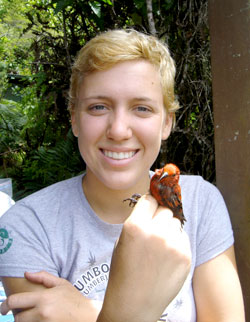
Neal’s nature photographer father was on a shoot in their home state of Hawaii when an employee with the Maui Forest Bird Recovery project mentioned their need for summer lab workers.
Michael Neal said that his daughter, a Cellular Molecular Biology major, was looking for a summer internship. The project’s Avian Conservation Research Facilitator, Hanna Mounce (‘03, Wildlife), quickly hired Tawny, knowing from personal experience that a Humboldt education would have prepared her well for the position.
Currently, the Maui Forest Bird Recovery project is focused on rehabilitating three species of Maui Honeycreeper birds: the Maui “Creeper,” or Alauahio, the Crested Honeycreeper, or Akohekohe, and the Maui Parrotbill. The parrotbill, or Kiwikiu, is the most threatened, with only an estimated 500 left.
These birds’ numbers have been devastated by avian malaria. Non-native birds adapted resistance to avian malaria, but these native birds have no defenses against the disease.
The group’s final goal is the translocation of the Parrotbill from the north side of Haleakala Volcano to the south side where conditions are drier and there are fewer mosquitoes. But before translocation can occur, the project must restore the habitat and conduct thorough research to determine if the relocated birds can survive the process.
This is where Neal’s work comes in. She spent most of the summer dissecting bird droppings, looking for clues about the birds’ diets. “It’s a lot of microscope work, with the tiniest pair of tweezers you’ve ever seen,” Neal says. “It’s fun and challenging – like playing Where’s Waldo.”
But her findings can have serious implications. If native and non-native birds are eating the same insects, competition may be driving native birds down-slope to lower altitudes and into mosquito territory. In Hanawi, the mosquito line, the highest altitude at which mosquitoes can survive, is approximately 4,000 vertical feet.
Neal also helped track the birds through bird banding. “We’re looking to see how they disperse out of the nest,” Neal says. “If the population in Hanawi is as dense as it can be, these young birds are going to get forced down-slope.” The further down-slope the birds travel, the more mosquitoes they encounter and the greater their risk of contracting avian malaria.
Although the group is focused on these endangered birds, it also collects data about other non-endangered native birds. If those populations change, the group can help before the birds get to the point of endangerment. “We’re keeping an eye on all their populations,” Neal says.
Despite the threat faced by the birds, the research setting at Hanawi is spectacular. For Neal, just going to and from work every day meant a hike of roughly 1,600 vertical feet.
“It’s astonishing that this beautiful, unique, pristine, wonderful place was in my backyard this whole time and I never knew what it meant,” Neal says. “Hanawi is very much what Hawaii was before anyone was there. It’s mind blowing. It’s so beautiful.”
Neal also had rewarding moments with the wildlife she researched.
“We took a male parrotbill to our banding station to be weighed and measured. We were processing this bird when we heard a female bird whistle. She had come to check up on her mate!” Neal says. “These are normally very timid animals and to get that close to us was very brave. It was the sweetest thing I’d ever seen.”